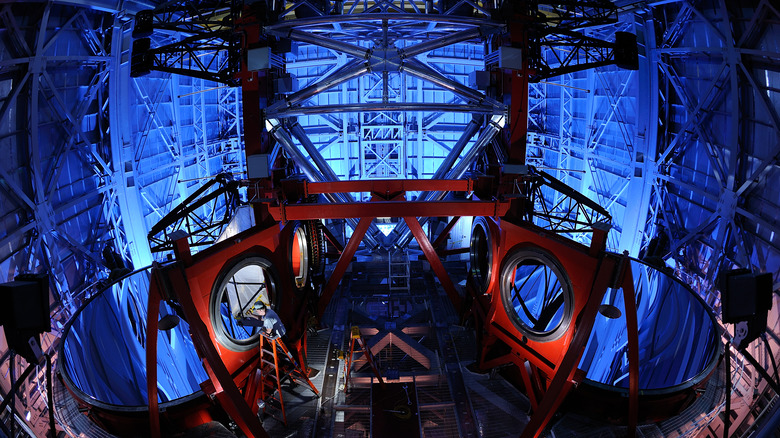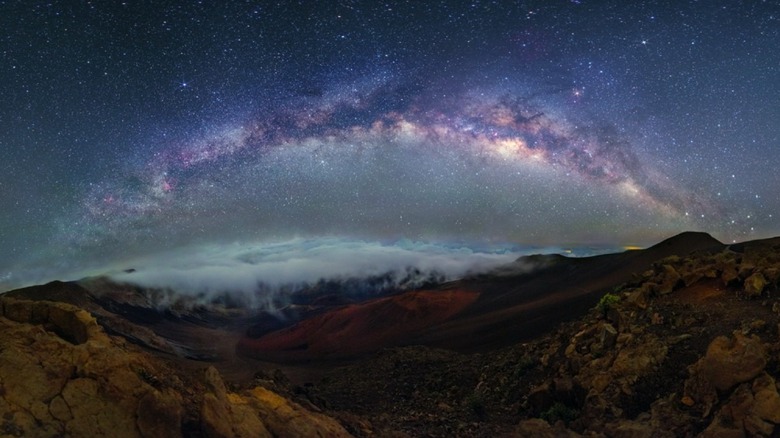Why The Large Binocular Telescope At Mount Graham Was Controversial
On March 15, 2012, the Large Binocular Telescope (LBT) made its first scientific results public; 25 years had passed since the project was first presented, but the wait was worth it. Among other things, the results showed off the telescope's top-tier ability to cancel out the blur of the Earth's atmosphere while also offering new insights into how stars are formed (via Phys.org). Using the LBT, scientists revealed exoplanets and their environments, a field expected to grow substantially thanks to the James Webb Space Telescope.
The Large Binocular Telescope is located in Arizona's Pinaleno Mountains at an altitude of about 7,545 feet. The observatory operates under an international collaboration between the University of Arizona, Italy's National Institute of Astrophysics, Germany's LBT Beteiligungsgesellschaft, and several other U.S. universities. Thanks to its unique design, power, and its vast array of scientific instruments, the LBT has earned a reputation for being a leading global telescope facility (via LBT).
While space telescopes like Hubble and Webb have eclipsed the capabilities of Earth telescopes, LBT should not be underestimated. The team at the observatory explains that they are on a mission to cover the full range of modern astrophysics, from exoplanets to the high-redshift universe. But the road to first light was not an easy one for the binocular telescope.
The controversy centered on the mountain
The construction of the telescope on Mount Graham found opposition from the San Carlos Apache tribe who claimed ancient rights to the land. It also faced resistance from environmentalists who were concerned about the observatory's potential impacts on the national park and its wildlife. The Indigenous Religious Traditions course at Colorado College explains that Mount Graham provides refuge for a vast diversity of wildlife. The endangered Mount Graham Red Squirrel, found nowhere else in the world, is among this diversity. For the San Carlos Apache tribe, the mountain is not only rich in old-growth forests dominated by spruce, but it is also considered a sacred land for both spiritual and historical reasons.
The LBT telescope is part of the Mount Graham International Observatory, which also includes the Vatican Advanced Technology Telescope and the Heinrich Hertz Telescope. Both the Vatican and the LBT telescope faced local resistance when construction began in the 1990s. The opposition, which included students, Apaches, and environmentalists, grouped under the Mount Grahan Coalition. They are still active and have several legal cases against the telescope group, according to the group's website.
The Mount Graham Coalition claims the U.S. Congress failed to stop the construction of the telescopes, and for the first time in history exempted a project from the National Environmental Policy Act and the Endangered Species Act. The Ohio State University's Department of Astronomy counters that claim, stating that Congress did not exempt the project but instead determined all of the legal requirements were met. Congress based its 1998 resolution on a three-year environmental and Native American cultural impact study conducted by the U.S. Forest Service. Wildlife studies in the following years revealed that the population of the endangered Red Squirrel was increasing and was not impacted by the telescopes (via Arizona Game and Fish Department).
Not the first environmental and space controversy
The controversies surrounding the Arizona telescopes may have dimmed out, but the Mount Graham Coalition still rejects the project. "For decades, Apaches, scientists, conservationists, and university students have resisted the University of Arizona's decision to build several large telescopes on the mountain's summit," they say. Such controversies aren't unusual and we've seen new ones surface over the years. Astronomers, for example, have raised their own concerns about reduced observation capabilities as a consequence of the growing number of satellites in low Earth orbit.
As well, SpaceX's Boca Chica base expansion plan was shut down by the U.S. Army Corps of Engineers in April 2022 over the company's alleged failure to provide environmental impact information. The planned expansion would have built over more than 17 acres of possibly environmentally-notable land that includes wetlands. Such areas are protected under the Clean Water Act, which protects natural resources and sources of drinking water. Even tourist rocket launches have proven controversial due to the ways they may possibly hurt the environment (via Phys.org).


